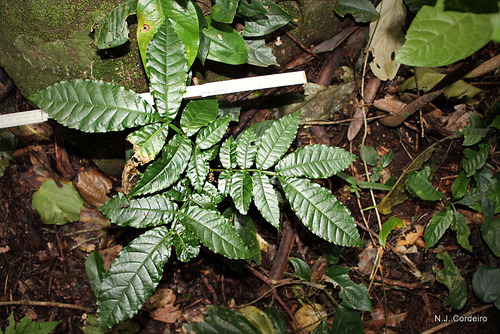Winged Bersama
Search
Wikipedia
| Winged bersama | |
|---|---|
|
Scientific classification | |
| Kingdom: | Plantae |
| Clade: | Tracheophytes |
| Clade: | Angiosperms |
| Clade: | Eudicots |
| Clade: | Rosids |
| Order: | Geraniales |
| Family: | Francoaceae |
| Genus: | Bersama |
| Species: |
B. abyssinica
|
| Binomial name | |
|
Bersama abyssinica | |

| |
|
Countries of occurrence
| |
| Synonyms | |
| |
Bersama abyssinica is a species of medium-sized evergreen tree in the Francoaceae family. The leaves are pinnately divided with a strongly winged rachis (hence the common name winged bersama).[2] The inflorescence is a spike.
This species is distributed across sub-Saharan Africa and includes two subspecies:[3]
- B. abyssinica Fresen. subsp. abyssinica Fresen.
- B. abyssinica Fresen. subsp. rosea (Hoyle) Mikkelsen[4]
The subspecies rosea is endemic to Tanzania, where it is considered vulnerable.[5]
Bersama abyssinica produces a hard, heavy wood that is used in the construction of houses in West Africa.[6]
References
- ^ IUCN SSC Global Tree Specialist Group.; Botanic Gardens Conservation International; et al. (BGCI) (2020). "Bersama abyssinica". IUCN Red List of Threatened Species. 2020: e.T146298209A153945468. doi:10.2305/IUCN.UK.2020-3.RLTS.T146298209A153945468.en. Retrieved 17 November 2021.
- ^ "Bersama abyssinica Fresen". Flora of Zimbabwe. Retrieved 2007-12-03.
- ^ "Bersama abyssinica Fresen. subsp. abyssinica Fresen. [family MELIANTHACEAE]". Aluka. Retrieved 2007-12-03.[dead link]
- ^ Mikkelsen, K. S.; O. Seberg (2001). "Morphometric analysis of the Bersama abyssinica Fresen. complex (Melianthaceae) in East Africa". Plant Systematics and Evolution. 227 (3–4): 157–182. doi:10.1007/s006060170046. S2CID 28513818.
- ^ Gereau, R.E.; Kabuye, C.; Kalema, J.; Kamau, P.; Kindeketa, W.; Luke, W.R.Q.; Lyaruu, H.V.M.; Malombe, I.; Mboya, E.I.; Mollel, N.; Njau, E.-F.; Schatz, G.E.; Sitoni, D.; Ssegawa, P.; Wabuyele, E. (2020). "Bersama rosea". IUCN Red List of Threatened Species. 2020: e.T34225A2851781. doi:10.2305/IUCN.UK.2020-3.RLTS.T34225A2851781.en. Retrieved 17 November 2021.
- ^ Heywood, V. H. (ed.) (1993). Flowering Plants of the World (2nd ed.). New York: Oxford University Press. pp. 191–192.CS1 maint: extra text: authors list (link)
External links
- Images from the Flora of Zimbabwe
- Dressler, S.; Schmidt, M. & Zizka, G. (2014). "Bersama abyssinica". African plants – a Photo Guide. Frankfurt/Main: Forschungsinstitut Senckenberg.

